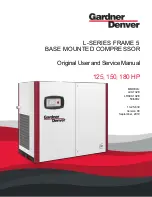
© 2017 Emerson Climate Technologies, Inc.
6
AE5-1377 R3
10.5. Loss of Phase Protection
If three phase supply is incorrectly connected to the
contactor terminals, or if a missing phase is sensed, an
error message will be shown on the diagnostic LED.
Reset is automatic once the correct phasing is sensed.
10.6. Motor Current Overload
•
All scroll compressors used in these condensing
units have an internal inherit motor protector.
•
The Copeland Scroll Outdoor Condensing Unit is
also equipped with two current sensors (CT1, CT2)
to monitor the electrical current of the condensing
unit. If the condensing unit current exceeds a pre-
defined current limit, the controller will take the
following actions:
➢
Stop the compressor for 3 minutes
➢
LED signal will display an Over Current Error for 3
minutes
➢
After a 3 minute delay the compressor will go
through a normal start
➢
The system will lock out after 6 over current trips
within an hour
For this function to operate, two of the power leads are
routed through the current sensing coils (CT1, CT2),
prior to the contactor, from the factory. See
10.7. Non-Adjustable High Pressure Control
This pressure sensing device is a nonadjustable, low
voltage pressure switch that will open at 435psig and
reset at 348psig in the event of high discharge pressure.
Its signal is monitored by the control board.
➢
In the event of a high pressure trip, the unit will stop
and then restart after a 3-minute delay.
➢
After 6 successive HP cut-outs within 1 hour, the
unit will lock-out.
➢
The lockout feature can be reset by disconnecting
the power source and then cycling power to the unit.
10.8. Adjustable Low Pressure Switch
An adjustable low pressure switch is provided as
standard equipment on both the medium and low
temperature condensing units. This control can be used
for a pump-down cycle if so desired. See
Pressure Control Settings for SJAL/M Units
Units introduced in mid-2013 include an electronic low
pressure control. The electronic low pressure control
provides more accurate cut-in and cut-out pressure
settings and maintains these settings without drifting
over time. See
10.9. Liquid Floodback Protection
•
Liquid refrigerant entering the compressor during
the run cycle, in excessive quantities, can damage
the compressor by diluting the lubricant, as well as
excessive stress on several components in the
compressor. Proper control of liquid refrigerant
within the system is an application issue and is
beyond control of this controller. However, the
controller can perform checks and alert the user that
liquid refrigerant floodback may be occurring and
immediate field service is required. This is only a
warning signal and will not terminate the operation
of the unit. See
•
Liquid Floodback Protection is acquired by
monitoring the compressor discharge temperature.
When the discharge line temperature falls below a
specified point, low suction line superheat may be
the cause.
10.10. Crankcase Heater
The crankcase heater is wired through a normally
closed contact of the compressor contactor which is
energized whenever the compressor cycles off.
10.11. Condenser Fan Speed Control
The Condenser Fan Speed Control will vary the speed
of the condenser fan motor for head pressure control
under low ambient conditions. There are two thermistor
type sensors that are connected to the control board.
These sensors monitor the condenser mid coil
temperatures and ambient air temperatures to control
the fan speed.
10.12. Enhanced Vapor Injection (EVI) Control
(Low temperature units only)
The EVI system improves low temperature operational
efficiency and provides a reliable low temperature
envelope. It is used to optimize performance and to
prevent the scroll set from overheating. This is done by
controlling the discharge line temperature (DLT) and
vapor injection superheat (VISH).
Enhanced vapor injection is accomplished by utilizing a
subcooling circuit. A heat exchanger is used to subcool
the liquid refrigerant before it enters the evaporator. As
a result of the subcooling done by the heat exchanger,
refrigerant will also be evaporated. This evaporated
refrigerant is then injected into the mid compression
cycle of the scroll compressor for overheat temperature
control.
Summary of Contents for Copeland Scroll Series
Page 9: ... 2017 Emerson Climate Technologies Inc 9 AE5 1377 R3 Figure 1 Nomenclature and Features ...
Page 14: ... 2017 Emerson Climate Technologies Inc 14 AE5 1377 R3 Drawings ...
Page 15: ... 2017 Emerson Climate Technologies Inc 15 AE5 1377 R3 ...
Page 16: ... 2017 Emerson Climate Technologies Inc 16 AE5 1377 R3 ...
Page 17: ... 2017 Emerson Climate Technologies Inc 17 AE5 1377 R3 ...
Page 18: ... 2017 Emerson Climate Technologies Inc 18 AE5 1377 R3 ...
Page 19: ... 2017 Emerson Climate Technologies Inc 19 AE5 1377 R3 ...
Page 20: ... 2017 Emerson Climate Technologies Inc 20 AE5 1377 R3 ...
Page 21: ... 2017 Emerson Climate Technologies Inc 21 AE5 1377 R3 ...
Page 22: ... 2017 Emerson Climate Technologies Inc 22 AE5 1377 R3 ...
Page 23: ... 2017 Emerson Climate Technologies Inc 23 AE5 1377 R3 ...
Page 39: ...APPENDIX 2 ...







































